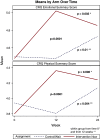Promoting Chronic Obstructive Pulmonary Disease Wellness through Remote Monitoring and Health Coaching: A Clinical Trial
- PMID: 35914215
- PMCID: PMC9667800
- DOI: 10.1513/AnnalsATS.202203-214OC
Promoting Chronic Obstructive Pulmonary Disease Wellness through Remote Monitoring and Health Coaching: A Clinical Trial
Abstract
Rationale: Quality of life (QoL) matters the most to patients with chronic obstructive pulmonary disease (COPD) and is associated with healthcare usage and survival. Pulmonary rehabilitation is the most effective intervention in improving QoL but has low uptake and adherence. Home-based programs are a proposed solution. However, there is a knowledge gap on effective and sustainable home-based programs impacting QoL in patients with COPD. Objectives: To determine whether remote patient monitoring with health coaching improves the physical and emotional disease-specific QoL measured by the Chronic Respiratory Questionnaire (CRQ). Methods: This multicenter clinical trial enrolled 375 adult patients with COPD, randomized to a 12-week remote patient monitoring with health coaching (n = 188) or wait-list usual care (n = 187). Primary outcomes include physical and emotional QoL measured by the CRQ summary scores. Prespecified secondary outcomes included the CRQ domains: dyspnea, CRQ-fatigue, CRQ-emotions, CRQ-mastery, daily physical activity, self-management abilities, symptoms of depression/anxiety, emergency room/hospital admissions, and sleep. Results: Participant age: 69 ± 9 years; 59% women; forced expiratory volume in 1 second percent predicted: 45 ± 19. At 12 weeks, there was a significant and clinically meaningful difference between the intervention versus the control group in the physical and emotional CRQ summary scores: change difference (95% confidence interval): 0.54 points (0.36-0.73), P < 0.001; 0.51 (0.39-0.69), P < 0.001, respectively. In addition, all CRQ domains, self-management, daily physical activity, sleep, and depression scores improved (P < 0.01). CRQ changes were maintained at 24 weeks. Conclusions: Remote monitoring with health coaching promotes COPD wellness and behavior change, given its effect on all aspects of QoL, self-management, daily physical activity, sleep, and depression scores. It represents an effective option for home-based rehabilitation. Clinical trial registered with clinicaltrials.gov (NCT03480386).
Keywords: COPD; disease management; quality of life; rehabilitation; self-management.
Figures





Similar articles
-
Feasibility of a Health Coaching and Home-Based Rehabilitation Intervention With Remote Monitoring for COPD.Respir Care. 2021 Jun;66(6):960-971. doi: 10.4187/respcare.08580. Epub 2021 Apr 27. Respir Care. 2021. PMID: 33906954 Free PMC article. Clinical Trial.
-
Does Working with a Health Coach Help Patients with COPD Improve Their Quality of Life and Breathe Easier? [Internet].Washington (DC): Patient-Centered Outcomes Research Institute (PCORI); 2019 Sep. Washington (DC): Patient-Centered Outcomes Research Institute (PCORI); 2019 Sep. PMID: 38620370 Free Books & Documents. Review.
-
Home-based Physical Activity Coaching, Physical Activity, and Health Care Utilization in Chronic Obstructive Pulmonary Disease. Chronic Obstructive Pulmonary Disease Self-Management Activation Research Trial Secondary Outcomes.Ann Am Thorac Soc. 2018 Apr;15(4):470-478. doi: 10.1513/AnnalsATS.201704-308OC. Ann Am Thorac Soc. 2018. PMID: 29283670 Free PMC article. Clinical Trial.
-
Chronic obstructive pulmonary disease self-management activation research trial (COPD-SMART): design and methods.Contemp Clin Trials. 2013 Jul;35(2):77-86. doi: 10.1016/j.cct.2013.05.004. Epub 2013 May 13. Contemp Clin Trials. 2013. PMID: 23680985 Free PMC article. Clinical Trial.
-
Does health coaching improve health-related quality of life and reduce hospital admissions in people with chronic obstructive pulmonary disease? A systematic review and meta-analysis.Br J Health Psychol. 2019 Sep;24(3):515-546. doi: 10.1111/bjhp.12366. Epub 2019 Apr 29. Br J Health Psychol. 2019. PMID: 31033121 Free PMC article.
Cited by
-
Home-Based Physical Activity Program With Health Coaching for participants With Chronic Obstructive Pulmonary Disease in Sweden: A Proof-of-Concept Pilot Study.Mayo Clin Proc Innov Qual Outcomes. 2023 Sep 30;7(5):470-475. doi: 10.1016/j.mayocpiqo.2023.07.005. eCollection 2023 Oct. Mayo Clin Proc Innov Qual Outcomes. 2023. PMID: 37811474 Free PMC article.
-
Feasibility Trial of a Comprehensive, Highly Patient-Centered COPD Self-Management Support Program.Chronic Obstr Pulm Dis. 2024 Jan 25;11(1):13-25. doi: 10.15326/jcopdf.2023.0419. Chronic Obstr Pulm Dis. 2024. PMID: 37813826 Free PMC article.
-
Rehabilitation Technologies for Chronic Conditions: Will We Sink or Swim?Healthcare (Basel). 2023 Oct 17;11(20):2751. doi: 10.3390/healthcare11202751. Healthcare (Basel). 2023. PMID: 37893825 Free PMC article. Review.
-
Maintenance Pulmonary Rehabilitation: An Update and Future Directions.Respir Care. 2024 May 28;69(6):724-739. doi: 10.4187/respcare.11609. Respir Care. 2024. PMID: 38744473 Free PMC article. Review.
-
Weight Loss Surgery Increases Kidney Transplant Rates in Patients With Renal Failure and Obesity.Mayo Clin Proc. 2024 May;99(5):705-715. doi: 10.1016/j.mayocp.2024.01.017. Mayo Clin Proc. 2024. PMID: 38702124 Free PMC article.
References
-
- Fan VS, Curtis JR, Tu SP, McDonell MB, Fihn SD, Ambulatory Care Quality Improvement Project Investigators Using quality of life to predict hospitalization and mortality in patients with obstructive lung diseases. Chest . 2002;122:429–436. - PubMed
-
- Domingo-Salvany A, Lamarca R, Ferrer M, Garcia-Aymerich J, Alonso J, Félez M, et al. Health-related quality of life and mortality in male patients with chronic obstructive pulmonary disease. Am J Respir Crit Care Med . 2002;166:680–685. - PubMed
-
- Halpin DMG, Criner GJ, Papi A, Singh D, Anzueto A, Martinez FJ, et al. Global initiative for the diagnosis, management, and prevention of chronic obstructive lung disease. The 2020 GOLD Science Committee Report on COVID-19 and chronic obstructive pulmonary disease. Am J Respir Crit Care Med . 2021;203:24–36. - PMC - PubMed
-
- Garvey C, Bayles MP, Hamm LF, Hill K, Holland A, Limberg TM, et al. Pulmonary rehabilitation exercise prescription in chronic obstructive pulmonary disease: review of selected guidelines: an official statement from the American Association of Cardiovascular and Pulmonary Rehabilitation. J Cardiopulm Rehabil Prev . 2016;36:75–83. - PubMed
Publication types
MeSH terms
Associated data
Grants and funding
LinkOut - more resources
Full Text Sources
Medical
Miscellaneous

